A horrific eight-alarm fire that began early Friday morning tore through a commercial building at the corner of Corey Road and Westbourne Terrace in Brighton, on the border with Brookline. Fortunately, the only injuries (to two Boston firefighters) were minor ones, but the businesses in the building, including music and dance studios, were devastated.
 |
| 185 Corey Road, Westbourne Terrace side, before the fire, as seen on Google Maps. (Click image for larger view) |
The building had gone through many changes and many tenants over the years, obscuring its origins. The original building was constructed as a stable in the late 19th century for Eben Jordan Jr., of Jordan Marsh, whose estate covered much of Corey Hill.
The overall shape of the building, sitting atop a still-existing stone foundation and including the rounded northwest corner, can be seen in the 1893 atlas and a recent aerial view.
 |
| 185 Corey Road in 1893 atlas and Google Maps aerial view |
The 1892 news item below notes that Jordan has received approval from Brookline to built a stable on Westbourne Terrace.
 |
| Brookline Chronicle, September 10, 1892, p2 |
(The building was mostly in Brookline when it was built, with only the western end in Brighton. The shaded line on the 1893 map, marking the boundary between Brookline and Brighton, passes through the building. Adjustments to the boundary soon after put the structure wholly in Brighton.)
The map below, from another 1893 atlas, shows the western
side of Corey Hill. The red outline has been added to show the
extent of Eben Jordan's property. Jordan's mansion is indicated by the blue arrow. It was torn down in 1955. The yellow arrow points to the stable at the corner or Corey Road and Westbourne Terrace.
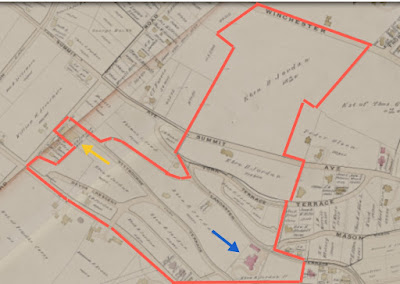 |
| Outline of Eben Jordan's property on Corey Hill in 1893 (Click image for larger view) |
The stable, known as Corey Hill Stables, was operated by several different proprietors over the years. In the Brookline Directory in 1894, H.O. Shaw advertised his services, including boarding of horses and the provision of carriages for shopping, weddings, receptions, and pleasure drives.
 |
| Brookline Directory, 1894 |
Later proprietors advertised in the Boston papers, offering horses, carriages, and, in winter, sleighs for sale. (The continued use of a Brookline address may have been because it was the mailing address or was considered more prestigious, or both.)
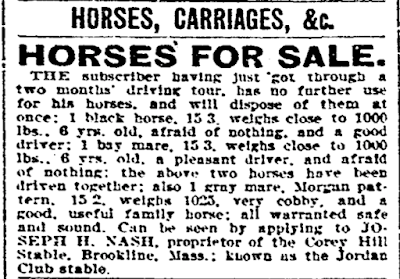 | ||
| Boston Herald, August 30, 1897 |
 |
| Boston Globe, November 3, 1899 |
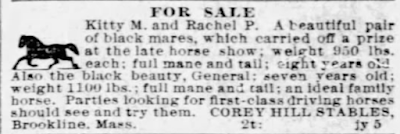 |
| Boston Transcript, July 5, 1901 |
 |
| Boston Transcript, January 28, 1905 |
 |
| Boston Transcript, April 13, 1912 |
By 1912, automobiles could be hired out as well.
 |
| 1912 Brookline Directory |
In 1913, the stable was purchased from the Jordan estate by H.P Hood & Sons, which used it through the end of the following decade as a distribution facility for Hood's milk. A 1924 Hood's ad gave the address as 136 Westbourne Terrace.
 |
| Brookline Chronicle, October 16, 1924, p8 |
In 1929, the building was sold to the Malone family, whose home and business extended down Corey Road to Washington Street. Bernard Malone ran a successful excavating and grading business. (Among the company's many projects were some of the early buildings of Boston College's new campus in Chestnut Hill, beginning with the excavation and foundation for the first building in 1909.)
The old stable was not shown in directories during the time it was owned by the Malones, but it was most likely used for both horses and storage. Bernard Malone, who at one time owned a stable on the grounds of the Metropolitan Racing Association's Speedway in Allston, continued to use horses in his business even after the coming of motorized vehicles. As late as 1946, he was selling horses for Newton that the city's street department was no longer using.
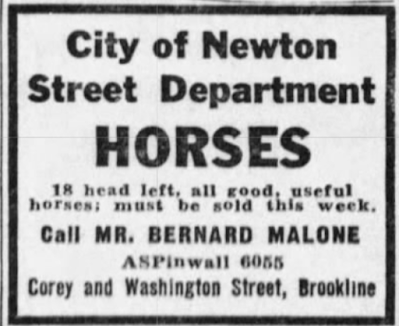 | |
| Boston Globe ad, March 31, 1946, p |
The next occupant of the old stable building, from the late 1940s to the 1970s was the Canter Construction Company, led by Eliot D. Canter. The company constructed numerous buildings in Boston and Cambridge, including 22 buildings for Harvard University, according to Canter's 2005 obituary in the Boston Globe.
 |
| Advertisement. Boston Globe, October 6 1957 |
Canter made several changes to the old stable building, including the removal of a third floor in 1955. In 1971, his real estate company, West Bourne Realty Trust, sought a variance to turn the building into 25 apartments. The request was denied by the Boston building commissioner in 1972 and, on appeal, by the city's Board of Appeals four years later. Canter sold the construction company, which was started by his father, a few years later.
By 1980, the old stable building had passed into the hands of the current owner, John Gately. (Ownership is now listed as Gately's La Salle Realty business.) Gately is a noted dealer in old Cadillacs and Cadillac parts through his Gately Restoration business and at one time had cars and parts in the Corey Road building.
The building has had numerous tenants in the 40+ years it has been owned by Gately, including, at various times, a career counseling firm, an antiques company, a liquidation company, an auto leasing business, and others. But it has been mostly known since the 1980s for its dance and music studios, including current tenants Music Maker Studios, Brookline Academy of Dance, and Zippah Studios/Zippah Records.
 |
| Boston Globe arts listings from 1981 (top), 1982 (middle), 1987 (bottom left), and 1999 (bottom right) |
 |
| In 1990, music producer Maurice Starr held auditions at 185 Corey Road for aspiring performers. Boston Herald, February 15, 1990 |
There was an earlier fire at the building, in 1985, that left the building with broken and missing doors and windows and left it exposed to the elements and to vandals. That brought warnings from Boston's Inspectional Services Department that the building would have to be repaired or razed. Repairs were made (after some delay) and the building has continued in use ever since.
Here's hoping the affected businesses can recover from this crushing blow. But will the old stable building itself, now nearing its 130th year, be rebuilt and continue its long history? We'll have to wait and see.
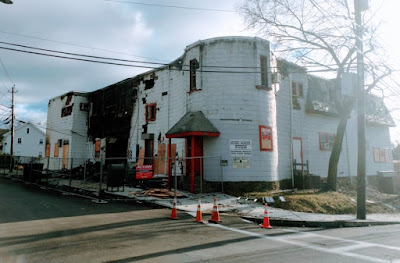 |
| 185 Corey Road, after December 2021 fire |
















